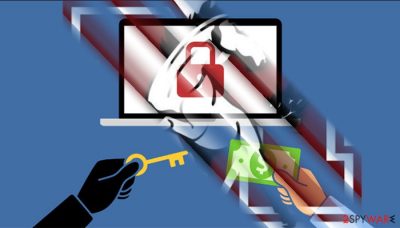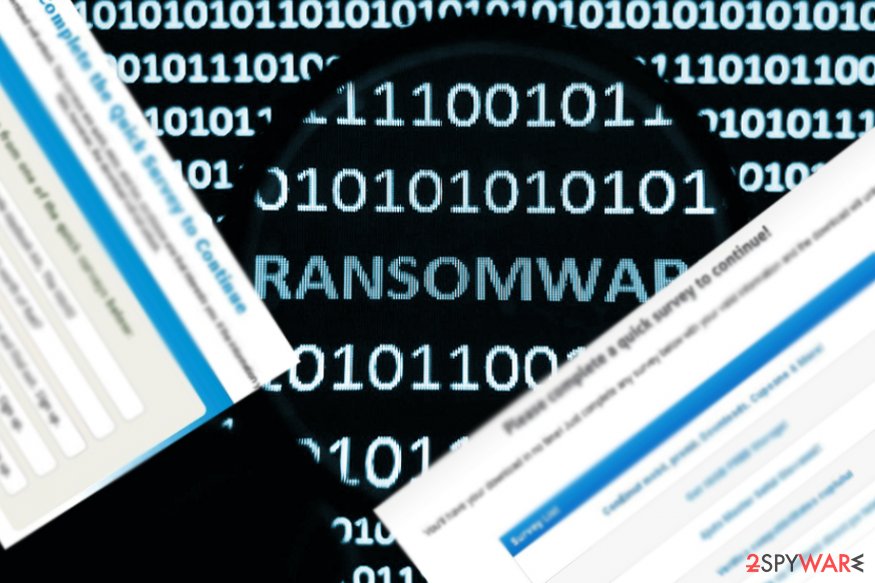J. Sterling ransomware (Removal Instructions) - Removal Guide
J. Sterling virus Removal Guide
What is J. Sterling ransomware?
J. Sterling ransomware assaulted high school with fake surveys

J. Sterling virus is defined as a file-encrypting threat programmed to infiltrate J.Sterling Morton High School system.[1] The malware was still in-development mode when it struck the school with a fake survey called “J. Sterling Student Survey”. Luckily, the malware did not encrypt any files.
For IT specialists, the GUI of the malware was quite suggestive of its origin; on the other hand, for students and employees of the school the survey might have seemed quite persuasive – the perpetrator used the logo and school-slogans. Considering this peculiarity and the fact that it did not encode any data implies that it might have been created as a prank by a student of the very school.
After entering the necessary data, student’s email and password, into the survey, the malware launched another GUI called “J. Sterling Ransomware.” It asked $10 in bitcoins. This sum was said to double if a victim failed to pay the money within 12 hours. The school was advised to remove J. Sterling ransomware. For that purpose, FortectIntego, Malwarebytes or another malware elimination tool might come in handy.
Luckily, this time, the malware did not inflict much damage. On the other hand, the very fact that the malware developer was able so easily to break into the system was alarming. Next time, more serious hackers may penetrate the system.
For instance, at the end of October parents of certain schools in Flathead County, Montana received alarming messages threatening to kill students in the recipients’ children schools.[2] Later on, the perpetrator turned out to be the Dark Overlord, the one responsible for ANC, Netflix and HBO hack.
Preventing ransomware assaults
These and previous cases of major data cases suggest that the virtual systems are still not properly protected. Low malware awareness[3] and failure to reshuffle passwords after a while also contribute to the high number of ransomware assaults.
In order to evade J. Sterling ransomware hijack, these tips might help:
- educate your employees about the dangers of opening corrupted spam email attachments
- backup the data
- use complex passwords comprised of characters, letters, and numbers (do not write them down on a sticky note attached to a computer monitor)
- update system and security data regularly
Speaking of J. Sterling removal, it should not have been difficult. All what the school experts had to do was to run the scan in Safe Mode. 
Eliminating J. Sterling ransomware
Threats similar to J. Sterling malware might also be labeled as screen lockers. ALT+F4 or specific combination unlocks the screen. After that, the victim should run an updated anti-virus tool and remove J. Sterling virus or similar threat.
Below instructions suggest how to run the computer in Safe Mode or perform System Restore. On the final note, be vigilant and do not forget to back up your data. After J. Sterling removal or elimination real file-encrypting virus, you may find some of the below-suggested programs practical.
Getting rid of J. Sterling virus. Follow these steps
Manual removal using Safe Mode
Important! →
Manual removal guide might be too complicated for regular computer users. It requires advanced IT knowledge to be performed correctly (if vital system files are removed or damaged, it might result in full Windows compromise), and it also might take hours to complete. Therefore, we highly advise using the automatic method provided above instead.
Step 1. Access Safe Mode with Networking
Manual malware removal should be best performed in the Safe Mode environment.
Windows 7 / Vista / XP
- Click Start > Shutdown > Restart > OK.
- When your computer becomes active, start pressing F8 button (if that does not work, try F2, F12, Del, etc. – it all depends on your motherboard model) multiple times until you see the Advanced Boot Options window.
- Select Safe Mode with Networking from the list.

Windows 10 / Windows 8
- Right-click on Start button and select Settings.

- Scroll down to pick Update & Security.

- On the left side of the window, pick Recovery.
- Now scroll down to find Advanced Startup section.
- Click Restart now.

- Select Troubleshoot.

- Go to Advanced options.

- Select Startup Settings.

- Press Restart.
- Now press 5 or click 5) Enable Safe Mode with Networking.

Step 2. Shut down suspicious processes
Windows Task Manager is a useful tool that shows all the processes running in the background. If malware is running a process, you need to shut it down:
- Press Ctrl + Shift + Esc on your keyboard to open Windows Task Manager.
- Click on More details.

- Scroll down to Background processes section, and look for anything suspicious.
- Right-click and select Open file location.

- Go back to the process, right-click and pick End Task.

- Delete the contents of the malicious folder.
Step 3. Check program Startup
- Press Ctrl + Shift + Esc on your keyboard to open Windows Task Manager.
- Go to Startup tab.
- Right-click on the suspicious program and pick Disable.

Step 4. Delete virus files
Malware-related files can be found in various places within your computer. Here are instructions that could help you find them:
- Type in Disk Cleanup in Windows search and press Enter.

- Select the drive you want to clean (C: is your main drive by default and is likely to be the one that has malicious files in).
- Scroll through the Files to delete list and select the following:
Temporary Internet Files
Downloads
Recycle Bin
Temporary files - Pick Clean up system files.

- You can also look for other malicious files hidden in the following folders (type these entries in Windows Search and press Enter):
%AppData%
%LocalAppData%
%ProgramData%
%WinDir%
After you are finished, reboot the PC in normal mode.
Remove J. Sterling using System Restore
In case Safe Mode seems inconvenient, perform System Restore. Note that this action does not delete the ransomware, but only enables you to eliminate it.
-
Step 1: Reboot your computer to Safe Mode with Command Prompt
Windows 7 / Vista / XP- Click Start → Shutdown → Restart → OK.
- When your computer becomes active, start pressing F8 multiple times until you see the Advanced Boot Options window.
-
Select Command Prompt from the list

Windows 10 / Windows 8- Press the Power button at the Windows login screen. Now press and hold Shift, which is on your keyboard, and click Restart..
- Now select Troubleshoot → Advanced options → Startup Settings and finally press Restart.
-
Once your computer becomes active, select Enable Safe Mode with Command Prompt in Startup Settings window.

-
Step 2: Restore your system files and settings
-
Once the Command Prompt window shows up, enter cd restore and click Enter.

-
Now type rstrui.exe and press Enter again..

-
When a new window shows up, click Next and select your restore point that is prior the infiltration of J. Sterling. After doing that, click Next.


-
Now click Yes to start system restore.

-
Once the Command Prompt window shows up, enter cd restore and click Enter.
Bonus: Recover your data
Guide which is presented above is supposed to help you remove J. Sterling from your computer. To recover your encrypted files, we recommend using a detailed guide prepared by 2-spyware.com security experts.If your files are encrypted by J. Sterling, you can use several methods to restore them:
What is Data Recovery Pro?
The tool might be of assistance when restoring damaged files. In some cases, it may even be of service recovering files affected by ransomware.
- Download Data Recovery Pro;
- Follow the steps of Data Recovery Setup and install the program on your computer;
- Launch it and scan your computer for files encrypted by J. Sterling ransomware;
- Restore them.
The usefulness of ShadowExplorer
If ransomware does not delete shadow volume copies in advance, it might be one of the last options to recover files encoded by crypto-malware.
- Download Shadow Explorer (http://shadowexplorer.com/);
- Follow a Shadow Explorer Setup Wizard and install this application on your computer;
- Launch the program and go through the drop down menu on the top left corner to select the disk of your encrypted data. Check what folders are there;
- Right-click on the folder you want to restore and select “Export”. You can also select where you want it to be stored.
Finally, you should always think about the protection of crypto-ransomwares. In order to protect your computer from J. Sterling and other ransomwares, use a reputable anti-spyware, such as FortectIntego, SpyHunter 5Combo Cleaner or Malwarebytes
How to prevent from getting ransomware
Stream videos without limitations, no matter where you are
There are multiple parties that could find out almost anything about you by checking your online activity. While this is highly unlikely, advertisers and tech companies are constantly tracking you online. The first step to privacy should be a secure browser that focuses on tracker reduction to a minimum.
Even if you employ a secure browser, you will not be able to access websites that are restricted due to local government laws or other reasons. In other words, you may not be able to stream Disney+ or US-based Netflix in some countries. To bypass these restrictions, you can employ a powerful Private Internet Access VPN, which provides dedicated servers for torrenting and streaming, not slowing you down in the process.
Data backups are important – recover your lost files
Ransomware is one of the biggest threats to personal data. Once it is executed on a machine, it launches a sophisticated encryption algorithm that locks all your files, although it does not destroy them. The most common misconception is that anti-malware software can return files to their previous states. This is not true, however, and data remains locked after the malicious payload is deleted.
While regular data backups are the only secure method to recover your files after a ransomware attack, tools such as Data Recovery Pro can also be effective and restore at least some of your lost data.
- ^ Lawrence Abrams. Ransomware Targets J. Sterling Morton High School Students With Fake Survey. BleepingComputer. News, reviews and tech support.
- ^ Edwin Rios. Hackers Are Stealing Sensitive Student Data—And Schools are Paying Thousands of Dollars to Get it Back. Mother Jones. Smart, fearless journalism.
- ^ Lucia Danes. Cyber threat forecasts for 2018. 2-spyware. Security and spyware news.





















